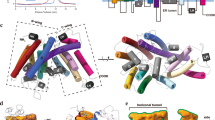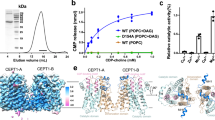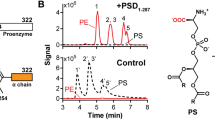Abstract
Phosphatidylcholines (PtdChos) comprise the most common phospholipid class in eukaryotic cells. In mammalian cells, these insoluble molecules are transferred between membranes by a highly specific phosphatidylcholine transfer protein (PC-TP) belonging to the steroidogenic acute regulatory protein related transfer (START) domain superfamily of hydrophobic ligand-binding proteins. The crystal structures of human PC-TP in complex with dilinoleoyl-PtdCho or palmitoyl-linoleoyl-PtdCho reveal that a single well-ordered PtdCho molecule occupies a centrally located tunnel. The positively charged choline headgroup of the lipid engages in cation–π interactions within a cage formed by the faces of three aromatic residues. These binding determinants and those for the phosphoryl group may be exposed to the lipid headgroup at the membrane–water interface by a conformational change involving the amphipathic C-terminal helix and an Ω-loop. The structures presented here provide a basis for rationalizing the specificity of PC-TP for PtdCho and may identify common features used by START proteins to bind their hydrophobic ligands.
This is a preview of subscription content, access via your institution
Access options
Subscribe to this journal
Receive 12 print issues and online access
$189.00 per year
only $15.75 per issue
Buy this article
- Purchase on Springer Link
- Instant access to full article PDF
Prices may be subject to local taxes which are calculated during checkout



Similar content being viewed by others
References
Smith, R. & Tanford, C. J. Mol. Biol. 67, 75–83 (1972).
Wirtz, K.W. & Zilversmit, D.B. J. Biol. Chem. 243, 3596–3602 (1968).
Geijtenbeek, T.B., Smith, A.J., Borst, P. & Wirtz, K.W. Biochem. J. 316, 49–55 (1996).
Cohen, D.E. & Green, R.M. Gene 163, 327–328 (1995).
van Helvoort, A. et al. Proc. Natl. Acad. Sci. USA 96, 11501–11506 (1999).
Wu, M.K., Boylan, M.O. & Cohen, D.E. Gene 235, 111–120 (1999).
Cohen, D.E., Green, R.M., Wu, M.K. & Beier, D.R. Biochim. Biophys. Acta 1447, 265–270 (1999).
Wirtz, K.W. Annu. Rev. Biochem. 60, 73–99 (1991).
Baez, J.M., Barbour, S.E. & Cohen, D.E. J. Biol. Chem. 277, 6198-6206 (2002).
Iyer, L.M., Koonin, E.V. & Aravind, L. Proteins 43, 134–144 (2001).
Ponting, C.P. & Aravind, L. Trends Biochem. Sci. 24, 130–132 (1999).
Ponting, C.P., Schultz, J., Milpetz, F. & Bork, P. Nucleic Acids Res. 27 229–232 (1999).
Schultz, J., Milpetz, F., Bork, P. & Ponting, C.P. Proc. Natl. Acad. Sci. USA 95, 5857–5864 (1998).
Tsujishata, Y. & Hurley, J.H. Nature Struct. Biol. 7, 408–414 (2000).
de Brouwer, A. Functional studies on the phosphatidylcholine transfer protein. Ph.D thesis, Utrecht Univ. (2002).
Gajhede, M. et al. Nature Struct. Biol. 3, 1040–1045 (1996).
Yoder, M.D. et al. J. Biol. Chem. 276, 9246–9252 (2001).
de Brouwer, A.P.M. et al. Chem. Phys. Lipids 112, 109–119 (2001).
Burley, S.K. & Petsko, G.A. Science 229, 23–28 (1985).
Gallivan, J.P. & Dougherty, D.A. Proc. Natl. Acad. Sci. USA 96, 9459–9464 (1999).
Bellamy, H.D., Lim, L.W., Mathews, F.S. & Dunham, W.R. J. Biol. Chem. 264, 11887–11892 (1989).
Sussman, J.L. et al. Science 253, 872–879 (1991).
Nielsen, P.R. et al. Nature 416, 103–107 (2002).
Jacobs, S.A. & Khorasanizadeh, S. Science 295, 2080–2083 (2002).
Wirtz, K.W., Devaux, P.F. & Bienvenue, A. Biochemistry 19, 3395–3399 (1980).
Johnson, L.W. & Zilversmit, D.B. Biochim. Biophys. Acta 375, 165–175 (1975).
McLean, L.R. & Phillips, M.C. Biochemistry 20, 2893–2900 (1981).
Feng, L., Chan, W.W., Roderick, S.L. & Cohen, D.E. Biochemistry 39, 15399–15409 (2000).
Bose, H.S., Sugawara, T., Strauss, J.F. III & Miller, W.L N. Engl. J. Med. 335, 1870–1878 (1996).
Chan, W.W., Roderick, S.L. & Cohen, D.E. Biochim. Biophys. Acta 1596, 1–5 (2001).
Otwinoski, Z. & Minor, W. Methods Enzymol. 276, 307–326 (1997).
Weeks, C.M. & Miller, R. J. Appl. Crystallogr. 32, 120–124 (1999).
Collaborative Computing Project, Number 4. Acta Crystallogr. D 50, 760–763 (1994).
Terwilliger, T.C. Acta Crystallogr. D 56, 965–972 (2000).
Jones, T.A., Zou, J.-Y., Cowan, S.W. & Kjeldgaard, M. Acta Crystallogr. A 47, 110–119 (1991).
Brünger, A.T. et al. Acta Crystallogr. D 54, 905–921 (1998).
Brünger, A.T. Nature 355, 472–475 (1992).
Ramachandran, G.N., Ramakrishnan, C. & Sasisekharan, V. J. Mol. Biol. 7, 95–99 (1963).
Laskowski, R.A., MacArthur, M.W., Moss, S.D. & Thornton, J.M. J. Appl. Crystallogr. 26, 283–291 (1993).
Feng, L. & Cohen, D.E. J. Lipid Res. 39, 1862–1869 (1998).
Evans, S.V. J. Mol. Graph. 11, 134–138 (1993).
Kraulis, P.J. J. Appl. Crystallogr. 24, 946–950 (1991).
Bacon, D.J. & Anderson, W.F. J. Mol. Graph. 6, 219–220 (1996).
Merrit, E.A. & Murphy, M.E.P. Acta Crystallogr. D 50, 869–873 (1994).
Acknowledgements
This work was supported by the National Institute of Diabetes and Digestive and Kidney Diseases and the Alexandrine and Alexander L. Sinsheimer Fund. W.W.C. is the recipient of an American Gastroenterological Association Summer Student Fellowship. M.W.V. was supported by a grant from the National Institute of Allergy and Infectious Diseases. We would like to acknowledge the assistance of M. Sullivan at NSLS beamline X9A of the Brookhaven National Laboratories.
Author information
Authors and Affiliations
Corresponding authors
Ethics declarations
Competing interests
The authors declare no competing financial interests.
Rights and permissions
About this article
Cite this article
Roderick, S., Chan, W., Agate, D. et al. Structure of human phosphatidylcholine transfer protein in complex with its ligand. Nat Struct Mol Biol 9, 507–511 (2002). https://doi.org/10.1038/nsb812
Received:
Accepted:
Published:
Issue Date:
DOI: https://doi.org/10.1038/nsb812



